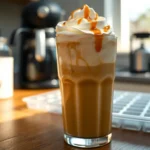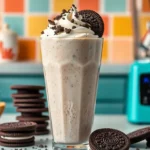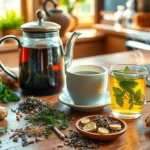Simple syrup transforms ordinary drinks into extraordinary cocktails and desserts with just two humble ingredients. We’ve all been there – standing at the bar or in our kitchen wondering how bartenders create those perfectly sweetened beverages that never have grainy sugar settling at the bottom.
This liquid gold isn’t just for cocktails though. We use simple syrup to sweeten iced tea, coffee drinks, fresh fruit salads, and even brush it onto cake layers for extra moisture. The beauty lies in its versatility and how effortlessly it dissolves into cold beverages.
Making simple syrup at home takes less than five minutes and costs a fraction of store-bought versions. Once you master this basic technique, you’ll never go back to granulated sugar for your cold drinks. We’re about to show you the foolproof method that guarantees perfect results every single time.
What Is Simple Syrup
Simple syrup stands as one of the most fundamental sweeteners in both home and professional kitchens. We define it as a liquid sweetener created by dissolving equal parts granulated sugar and water through gentle heat. This basic mixture transforms solid sugar crystals into a smooth liquid that blends effortlessly into any beverage or recipe.
The beauty of simple syrup lies in its straightforward composition. Water serves as the solvent while sugar provides the sweetness creating a clear syrup that won’t alter the appearance of your drinks. Unlike granulated sugar that settles at the bottom of cold beverages simple syrup incorporates immediately and completely.
Professional bartenders rely on simple syrup as their go-to sweetener because it eliminates the grittiness that comes from undissolved sugar. We appreciate how this liquid sweetener maintains consistent flavor distribution throughout cocktails and mocktails. The syrup’s neutral taste allows other flavors to shine while providing the perfect level of sweetness.
Simple syrup serves multiple purposes beyond cocktail making. Bakers use it to brush cake layers for added moisture while coffee enthusiasts prefer it over granulated sugar in iced beverages. The syrup’s versatility extends to homemade sodas fruit salads and even as a base for flavored syrups.
The standard ratio creates what we call “1:1 simple syrup” meaning one part sugar to one part water. This ratio produces a medium-bodied syrup that works well in most applications. Some recipes call for “rich simple syrup” which uses a 2:1 sugar to water ratio resulting in a thicker more concentrated sweetener.
Storage proves remarkably simple as the syrup keeps in the refrigerator for up to one month. We recommend storing it in a clean glass jar or bottle with a tight-fitting lid to prevent contamination and maintain freshness.
Ingredients

We need just two basic ingredients to create perfect simple syrup at home. Our recipe uses the classic 1:1 ratio that professional bartenders rely on for consistent results.
Essential Ingredients:
- 1 cup granulated sugar
- 1 cup water
Optional Flavor Enhancements:
- Fresh herbs (mint, rosemary, or basil)
- Citrus peels (lemon, lime, or orange)
- Berries for fruit-infused variations
- Fresh ginger for a spicy twist
The beauty of simple syrup lies in its minimal ingredient list. Granulated white sugar works best because it dissolves completely without adding color or competing flavors. We recommend using filtered water when possible to ensure the cleanest taste in your finished syrup.
Our optional ingredients allow you to customize your simple syrup for exact cocktails or beverages. Fresh rosemary creates an earthy note perfect for gin-based drinks, while mint adds refreshing brightness to summer cocktails. Citrus peels provide aromatic oils that enhance the syrup’s complexity without overwhelming sweetness.
For those seeking richer sweetness, we can adjust the ratio to 2:1 sugar to water. This creates a more concentrated syrup that works beautifully in dessert applications and stronger cocktails where you want maximum sweetness with minimal dilution.
Equipment Needed

Making simple syrup requires minimal kitchen equipment that most home cooks already have on hand. We recommend gathering these essential tools before starting the process to ensure smooth preparation.
Heavy-Bottomed Saucepan or Small Pot serves as our primary cooking vessel. We prefer heavy-bottomed pans because they distribute heat evenly and prevent hot spots that could cause the sugar to caramelize unexpectedly. A medium-sized saucepan works perfectly for standard batches.
Whisk becomes our stirring tool of choice for dissolving sugar efficiently. We find that whisking helps break up any sugar clumps and ensures complete dissolution faster than using a wooden spoon. The wire loops create better agitation than solid utensils.
Cheesecloth offers optional straining capabilities when we infuse our syrup with herbs or other flavorings. We use this fine mesh material to remove solid particles and achieve a crystal-clear final product. Fine mesh sieves can substitute if cheesecloth is unavailable.
Funnel prevents messy spills during the transfer process. We position this tool over our storage containers to guide the cooled syrup without waste or cleanup headaches. Wide-mouth funnels work best for easy pouring.
Glass Mason Jar or Squirt Bottle provides ideal storage answers for our finished syrup. We choose glass containers because they don’t absorb flavors or odors like plastic alternatives. Mason jars offer easy pouring while squirt bottles provide precise dispensing control for cocktail preparation.
These tools work together to create a streamlined simple syrup making process. We keep everything within reach before heating our sugar and water mixture to maintain efficiency throughout preparation.
Instructions

Making simple syrup involves three straightforward steps that take just minutes to complete. We’ll walk you through each phase to ensure perfect results every time.
Prep
We start by gathering our ingredients using the essential 1:1 ratio of water to sugar. Measure 1 cup of granulated sugar and 1 cup of water into a small saucepan. Whisk the mixture thoroughly until the sugar and water combine evenly throughout the pan.
For flavor variations, we can prepare optional ingredients like fresh mint leaves, rosemary sprigs, or lavender during this stage. Keep a heat-resistant glass jar nearby for storage once our syrup finishes cooking.
Cook
Place the saucepan over medium heat and stir the mixture continuously as it warms. We watch for the sugar to dissolve completely, which typically takes 2-3 minutes of constant stirring. The mixture will appear clear once the sugar fully incorporates into the water.
Bring the syrup to a rolling boil to ensure complete sugar dissolution. This boiling step guarantees our syrup will have a smooth consistency without any granular texture. Remove the saucepan from heat immediately once boiling begins.
Cool and Store
Allow the syrup to cool completely at room temperature before transferring to storage containers. We recommend waiting 15-20 minutes for the syrup to reach room temperature naturally.
Pour the cooled syrup into a clean glass jar with a tight-fitting lid using a funnel to prevent spills. Store the finished syrup in the refrigerator where it will maintain freshness for up to one month. For longer storage, we can freeze the syrup for several months without affecting its quality or taste.
Simple Syrup Variations

Once you master the basic simple syrup technique, we can explore creative variations that transform this foundational sweetener into unique flavor profiles. These variations allow us to customize our cocktails, desserts, and beverages with distinctive tastes that elevate ordinary drinks into extraordinary creations.
Flavored Simple Syrups
Fruit syrups offer vibrant flavors that complement seasonal cocktails and refreshing beverages. We combine fresh fruits like lemons, limes, or berries with sugar and water, then simmer the mixture until the flavors are fully infused. Citrus fruits work particularly well because their natural oils release during the heating process, creating bright and zesty syrups perfect for summer drinks.
Herbal syrups provide aromatic complexity that transforms basic cocktails into sophisticated creations. We add fresh herbs like mint or basil to our sugar and water mixture, allowing the gentle heat to extract their essential oils. These herbal infusions create refreshing syrups that pair beautifully with both alcoholic and non-alcoholic beverages.
Spice-infused syrups introduce warming elements that enhance winter cocktails and desserts. We can incorporate ingredients like cinnamon sticks, star anise, or fresh ginger during the simmering process. The key to successful flavored syrups lies in balancing the infusion time to achieve the desired intensity without overwhelming the sweetness.
Rich Simple Syrup
Rich simple syrup uses a 2:1 ratio of sugar to water, creating a more concentrated sweetener that works exceptionally well in stronger cocktails. We prepare this variation using the same basic technique as standard simple syrup, but the higher sugar content produces a thicker consistency that coats the back of a spoon.
This concentrated version dissolves more easily in cold beverages while providing intense sweetness with smaller quantities. We find rich simple syrup particularly valuable for cocktails that require substantial sweetening power without diluting the alcohol content. The syrup’s viscous texture also makes it ideal for layering in drinks or drizzling over desserts.
Professional bartenders often prefer rich simple syrup because it maintains consistency across multiple cocktail preparations. We store this variation using the same refrigeration guidelines as standard simple syrup, though its higher sugar content naturally extends its shelf life.
Honey Simple Syrup
Honey simple syrup combines the natural sweetness of honey with water to create a liquid sweetener that blends seamlessly into cold beverages. We gently heat honey and water together in a saucepan until the honey dissolves completely, creating a smooth consistency without the crystallization that can occur with raw honey.
This variation offers complex floral notes that vary depending on the honey source, from delicate wildflower varieties to robust buckwheat honey. We recommend using a 1:1 ratio of honey to water for most applications, though the ratio can be adjusted based on the honey’s natural thickness and desired sweetness level.
The gentle heating process preserves the honey’s beneficial properties while creating a syrup that mixes effortlessly into cocktails, tea, and coffee. We let the mixture cool completely before storing it in the refrigerator, where it maintains its quality for several weeks.
Storage Tips

Proper storage ensures our simple syrup maintains its quality and extends its shelf life significantly. We recommend transferring the cooled syrup into clean glass jars or bottles with tight-fitting lids to prevent contamination and preserve freshness.
Refrigeration remains the most reliable storage method for simple syrup. Our homemade syrup stays fresh in the refrigerator for up to one month when stored correctly. Glass containers work best because they don’t absorb flavors or odors that could affect the syrup’s taste. We suggest labeling containers with the preparation date to track freshness easily.
Temperature consistency plays a crucial role in maintaining syrup quality. Store containers in the main body of the refrigerator rather than the door where temperature fluctuations occur more frequently. This practice helps prevent crystallization and maintains the smooth consistency we desire.
Freezing offers an excellent option for longer storage periods. Pour the syrup into airtight containers or ice cube trays for convenient portioning. Frozen simple syrup maintains its quality indefinitely without compromising flavor or texture. Ice cube portions make it particularly easy to add exact amounts to individual drinks.
Contamination prevention requires using clean utensils each time we access stored syrup. Avoid double-dipping or introducing moisture from wet spoons into the container. These simple precautions prevent bacterial growth and extend storage life.
Signs of spoilage include cloudiness, unusual odors, or mold growth around the container edges. Fresh simple syrup appears crystal clear and odorless. We recommend discarding any syrup showing these warning signs immediately.
For flavored variations containing fresh ingredients like herbs or citrus peels, storage time decreases to approximately two weeks in the refrigerator. These additions introduce additional moisture and organic matter that can spoil more quickly than plain syrup.
Uses for Simple Syrup

Now that we’ve mastered making simple syrup at home, let’s explore the countless ways this versatile sweetener transforms our favorite drinks and desserts. Simple syrup elevates everything from classic cocktails to homemade baked goods with its smooth blending ability and consistent sweetness.
Cocktails and Drinks
Simple syrup serves as the foundation for countless classic cocktails where granulated sugar would simply settle to the bottom. We reach for our homemade syrup when crafting an Old Fashioned, ensuring the sweetener distributes evenly throughout the whiskey without any gritty texture. Whiskey Sours benefit tremendously from simple syrup’s smooth integration, creating a perfectly balanced cocktail every time.
Tom Collins and Gimlet cocktails showcase simple syrup’s ability to bind flavors seamlessly without overpowering the spirit’s character. We love using simple syrup in Watermelon Margaritas where it complements the fruit’s natural sweetness while maintaining the drink’s smooth consistency.
Flavored simple syrups open endless creative possibilities for our cocktail experiments. We infuse fresh mint into our syrup for mojitos and mint juleps, while rosemary-infused versions add sophistication to gin-based cocktails. These herb-infused syrups eliminate the need for muddling while delivering concentrated flavor throughout each sip.
Desserts and Baking
Simple syrup transforms our baking by adding moisture and extending the freshness of cakes and pastries. We brush simple syrup onto cake layers before frosting to lock in moisture and prevent drying, especially crucial for delicate sponge cakes. This technique keeps our homemade cakes tender and flavorful for days longer than without the syrup treatment.
Sorbet making becomes effortless with simple syrup since it blends immediately into our fruit purees without requiring additional mixing time. The syrup creates a smoother texture in frozen desserts while preventing ice crystals from forming during the freezing process. We prefer simple syrup over granulated sugar in our homemade ice creams for this same smooth integration.
Our fruit compotes and glazes benefit from simple syrup’s liquid form, allowing us to adjust sweetness levels precisely without worrying about undissolved sugar affecting the final texture.
Coffee and Tea
Simple syrup revolutionizes our cold beverage game by eliminating the frustration of undissolved sugar granules settling at the bottom of iced drinks. We add simple syrup to our iced coffee and cold brew for consistent sweetness that distributes evenly throughout the entire drink. Sweet tea preparation becomes foolproof with simple syrup since we can adjust sweetness levels after brewing without any texture issues.
Our homemade lemonades achieve perfect balance when sweetened with simple syrup, creating a smooth drink without any grainy residue. We keep simple syrup on hand for sweetening iced teas of all varieties, from classic black tea to herbal blends that benefit from gentle sweetening without competing flavors.
Hot beverages also benefit from simple syrup’s convenience, especially when we want to add sweetness to specialty coffee drinks or artisanal teas without waiting for sugar to dissolve completely.
Troubleshooting Common Issues

Even with simple syrup’s straightforward preparation, we occasionally encounter challenges that can affect the final product’s quality and consistency. Understanding these common issues helps us create perfect syrup every time.
Crystallization presents the most frequent problem when making simple syrup. Sugar crystals form when the mixture cools too quickly or when undissolved sugar particles remain in the solution. We can prevent crystallization by ensuring complete sugar dissolution during the heating process and stirring gently until the mixture reaches a rolling boil. If crystals do appear, we simply reheat the syrup gently while stirring until the sugar dissolves completely again.
Thick consistency sometimes develops when we accidentally use too much sugar or cook the mixture too long. The syrup should flow smoothly from a spoon rather than coating it heavily. We can thin overly thick syrup by adding small amounts of water and reheating the mixture gently until we achieve the desired consistency.
Cloudiness in finished syrup typically indicates impurities in the water or sugar, or cooking at temperatures that are too high. We recommend using filtered water and high-quality granulated sugar to maintain clarity. Gentle heating prevents the formation of compounds that cause cloudiness in the final product.
Contamination and spoilage occur when we don’t maintain proper cleanliness during preparation or storage. We must use sterilized containers and utensils to prevent mold growth and bacterial contamination. Signs of spoilage include unusual odors, visible mold, or a slimy texture on the syrup’s surface.
Uneven sweetness happens when sugar doesn’t dissolve completely during cooking. We solve this by whisking the mixture thoroughly before heating and continuing to stir until every granule disappears. The syrup should appear completely clear with no visible sugar particles floating in the solution.
Flavor separation in infused syrups occurs when we don’t strain the mixture properly or when plant materials continue to steep too long. We prevent this by removing herbs, spices, or fruit pieces immediately after achieving the desired flavor intensity and straining through fine mesh or cheesecloth.
Make-Ahead Instructions

We recommend preparing simple syrup well in advance of your planned use. This liquid sweetener can be made several days or even weeks ahead of time without compromising its quality or effectiveness.
Batch Preparation Timeline
Our experience shows that simple syrup stores beautifully for extended periods when properly prepared. We can make large quantities during weekend meal prep sessions to have sweetener ready throughout the week. The standard 1:1 ratio simple syrup maintains its consistency and sweetness for up to one month when stored correctly.
Advance Storage Guidelines
| Storage Method | Duration | Container Type |
|---|---|---|
| Refrigerator | Up to 4 weeks | Glass jar with tight lid |
| Freezer | Up to 6 months | Airtight container |
| Ice cube trays | Up to 6 months | Silicone or plastic trays |
We pour cooled simple syrup into clean glass jars immediately after preparation. The syrup reaches room temperature within 30 minutes and can be transferred directly to refrigerated storage. This approach prevents condensation from forming inside storage containers.
Party and Event Planning
Large gatherings benefit from advance simple syrup preparation. We typically make triple or quadruple batches when hosting cocktail parties or special events. The syrup’s neutral flavor profile makes it perfect for creating multiple drink options without competing flavors.
Flavored Variations Planning
Infused simple syrups require different advance preparation timelines. We prepare herb-infused versions 2-3 days ahead to allow flavors to meld properly. Citrus-infused syrups reach peak flavor after 24 hours of refrigeration. Spice-infused varieties like cinnamon or ginger benefit from 48-hour advance preparation.
Quality Maintenance Tips
We label each container with preparation dates to track freshness accurately. Simple syrup maintains its clarity and sweetness throughout its storage period when kept at consistent refrigerator temperatures. The syrup’s viscosity remains unchanged during proper storage making it ready for immediate use in cocktails and recipes.
Conclusion
Now you’re equipped with everything needed to make perfect simple syrup at home. This versatile sweetener will transform your beverages and desserts while saving you money compared to store-bought alternatives.
We’ve shown you that mastering simple syrup isn’t just about following a recipe—it’s about understanding the techniques that ensure consistent results every time. From proper storage methods to creative flavor variations you can customize this basic syrup to match any drink or dessert you’re creating.
Start with the classic 1:1 ratio and experiment with different flavors as you become more comfortable with the process. Your cocktails coffee drinks and baked goods will never be the same once you discover how much better homemade simple syrup tastes compared to granulated sugar.
Frequently Asked Questions
What is simple syrup and what is it made of?
Simple syrup is a liquid sweetener made from just two ingredients: equal parts granulated sugar and water. The mixture is gently heated until the sugar completely dissolves, creating a smooth liquid that blends effortlessly into beverages and recipes without leaving any gritty texture.
How long does homemade simple syrup last?
Homemade simple syrup can be stored in the refrigerator for up to one month when kept in a clean glass jar or bottle with a tight-fitting lid. For longer storage, it can be frozen for up to six months without compromising quality. Flavored variations typically last about two weeks.
What’s the difference between regular and rich simple syrup?
Regular simple syrup uses a 1:1 ratio of sugar to water, while rich simple syrup uses a 2:1 ratio (two parts sugar to one part water). Rich simple syrup is thicker, more concentrated, and ideal for stronger cocktails and dessert applications.
Can I make flavored simple syrup variations?
Yes, you can easily customize simple syrup by adding fresh herbs, citrus peels, berries, ginger, or spices during the cooking process. These flavored variations add unique taste profiles to cocktails and beverages, though they typically have a shorter shelf life of about two weeks.
Why is simple syrup better than regular sugar in cold drinks?
Simple syrup dissolves instantly in cold beverages, eliminating the gritty texture and settling that occurs with granulated sugar. It ensures even sweetness distribution throughout the drink and prevents undissolved sugar from accumulating at the bottom of glasses.
What kitchen equipment do I need to make simple syrup?
You only need basic kitchen tools: a heavy-bottomed saucepan for even heat distribution, a whisk for efficient mixing, and a clean glass container for storage. Optional items include cheesecloth for straining flavored versions and a funnel to prevent spills during transfer.
How do I know if my simple syrup has gone bad?
Signs of spoiled simple syrup include cloudiness, unusual odors, mold growth, or any visible particles floating in the liquid. Fresh simple syrup should be clear and odorless. Always use clean utensils when handling to prevent contamination and extend shelf life.
Can I make simple syrup ahead of time for parties?
Absolutely! Simple syrup is perfect for make-ahead preparation. You can batch-make large quantities several days or weeks in advance without quality loss. Store in labeled containers with preparation dates, and consider freezing portions in ice cube trays for easy serving at events.












